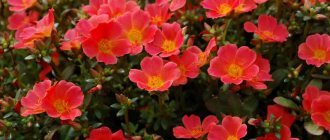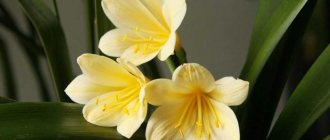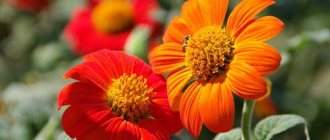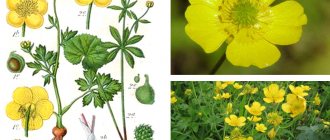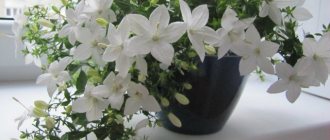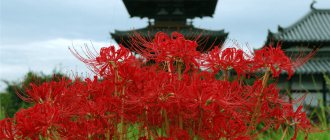Author: Natalya Category: Garden plants Published: January 04, 2019Republished: February 05, 2019Last edits: November 03, 2020
- Preparing the soil for planting
- Planting on a windowsill
- Excavation and storage
Ranunculus is a flower of tenderness, a flower of inspiration. No wonder brides, bloggers and photographers love him so much! Today, more than 600 species of ranunculus are known, just imagine this fairy-tale kingdom! Choosing a ranunculus variety for yourself is like judging a beauty contest; it’s not an easy task, you’ll agree. Of course, there is still the choice of seed material and care... But we will help you easily figure this out.
- How to prolong the flowering of a beautiful ranunculus in a pot?
- Is it possible to plant different ranunculi in one pot?
- Is it necessary to dig up the tubers of this delicate plant every time for wintering at home?
- What fertilizers can harm ranunculus flowering?
Read our article.
Planting and caring for ranunculus
- Planting: planting tubers in late April or early May, sowing seeds for seedlings in early March.
- Excavation: first half of autumn.
- Storage: in a paper bag at a temperature of 4-5 ˚C and good air circulation.
- Flowering: June-August.
- Lighting: bright light, partial shade.
- Soil: neutral, fertile, drained and light. Loam is not suitable.
- Watering: moderate, regular.
- Feeding: only during the flowering period, once every 2 weeks with potassium fertilizers.
- Reproduction: tubers, seeds.
- Pests: cabbage butterflies, spider mites, nematodes.
- Diseases: root rot, powdery mildew, gray rot.
Read more about growing ranunculus below.
Ranunculus (lat. Ranunculus) , or Asian buttercup (garden) is a plant of the buttercup family native to Asia Minor. The ancient scientist Pliny named them so (translated from Latin, ranunculus means “frog”) because many types of buttercup, like all amphibians, love marshy areas. Ranunculus was brought to England from Turkey in the 16th century and immediately became a favorite of flower growers, but by the end of the 19th century its popularity faded somewhat and was revived only in the present century. Today, more than 600 species of ranunculus are known.
The good thing about the ranunculus flower is that it can stand in a vase with water for up to two weeks. In Italy, garden buttercups are called “golden buttons of the meadows.” There is a beautiful legend that buttercups are small stars, turned by Jesus into flowers and presented to his mother as a sign of respect and love...
- Zamanikha
Wild species of ranunculus
In addition to ornamental varieties, ranunculus has many wild varieties , many of which have medicinal properties. Wild varieties can be found everywhere - from meadows, valleys and fields, to forests, floodplains and mountainous areas. Natural specimens, as a rule, begin to bloom earlier than garden buttercups.
Only people who prefer to be outdoors on weekends can see wild varieties. Some avid gardeners grow wild buttercups in their flower beds , creating alpine slides, rockeries and other landscape decorations.
Let's look at a few of the most popular:
Acrid buttercup (Ranunculus acris) . The plant is 20-50 centimeters high with yellow flowers reaching 2 centimeters in diameter. Dangerous for mucous membranes. Causes irritation upon contact.
Multi-flowered buttercup (Ranunculus polyanthemos) . The species is widespread in Ukrainian forests. May be found in dry meadows or grassy slopes. Has bright yellow inflorescences. Flowering time is from June to August.
Creeping buttercup (Ranunculus repens). It belongs to poisonous plants, but still this does not prevent gardeners from using plants like bindweed when decorating flower beds. It is used as a ground cover to fill empty areas. Another variety is the poisonous buttercup (Ranunculus sceleratus)
Water (marsh) buttercup (Ranunculus aquatilis). The main habitat is swamps and flooded meadows. Water buttercup (inundatus) - Ranunculus inundatus, belongs to the same category of plants.
Buttercup aconitifolius . A tall plant reaching 1 meter in height. Includes white and gold colors with terry shapes.
Alpine buttercup (alpestris) - includes annual and perennial varieties. The Russian flower grows in the forests of Western and Eastern Siberia.
Buttercup glacial or Bekvicia glacial. Full name: Ranunculus glacialis. The main places where wild varieties grow are rocky areas, cliffs and the banks of mountain rivers.
Japanese buttercup (japonicas). Unfortunately, it is practically unknown in Russia.
Spring clearweed - Ficaria Verna (formerly Ranunculus Ficaria L.). If you want to purchase this variety in the store, you need to look for it under the name “Spring buttercup collarette.” This name is typical for Western flower growers. In our regions it is called Chistyak. The leaves are dark green in color with deep veins. The shape of the flowers resembles small yellow anemones. Flowering time is May. A synonym for the name, often used among the people, is common chickweed (Buttercup ficaria).
Spring buttercup - Brazen Hussy - perennial - wild plant, not exceeding 10 centimeters in height. Flowering begins after the snow melts. It has bright yellow flowers. When grown in gardens, it prefers partial shade with soil of moderate humidity.
Attention! When growing wild varieties in your flowerbed, you need to be extremely careful, since many buttercups growing in the wild are classified as poisonous and if you come into contact with them, there is a risk of harm to health.
Botanical description
Ranunculus asiatica
This is a very beautiful flower. They grow it both in the garden and at home in pots, decorating terraces, balconies and living rooms with it. The plant reaches a height of 20-80 cm, it has deeply dissected leaves and strong stems. The rhizomes are tubers that look like crow's feet. Both the stocky rhizomes, leaves, and stems of the ranunculus are similar to the leaves, stems, and rhizomes of the dahlia. Beautiful double, semi-double and densely double ranunculus inflorescences of various shades, except blue and light blue, reach a diameter of 5-10 cm and consistently bloom from May to August. When they begin to open, they look like roses, and when they open, they look like double poppies. White ranunculus and pink ranunculus are very attractive to brides, who are happy to include them in their wedding bouquets.
However, it should be remembered that ranunculus juice is poisonous.
In culture, species and varieties of Asian ranunculus are grown, which initially has two varieties: Persian ranunculus (Ranunculus Persian), whose inflorescences resemble a rose, and African ranunculus, or turban-shaped (Ranunculus africanus), whose inflorescences resemble a peony.
Common varieties
Ranunculus is divided into different varieties.
Let's list some of them:
Elegance . Has many colors. It looks very beautiful in a cut bouquet of the “white/red” with white “white” petals, crowned with a burgundy crown, or lemon buds bordered along the edge with a purple stripe. There are also orange with a yellow center and red “red”.
The Burgundy variety is characterized by dark “dark” , almost black “black” , burgundy “bordo” flowers. Using different color shades, you can create beautiful “mix” compositions . Often used to create mini bouquets. It is recommended to cut the trunk of a flowering plant at an angle . This will provide a larger area for food.
Clooney. The shape of the bud resembles the Elegance variety, but the head is larger. The most popular is the Hanoi variety with a soft pink “pink-light” color. Some varieties of clonies can rival peonies in size. Subspecies related to this variety: Sangria, Sherry .
Cluny Pon-pon. Super-resistant and the largest type of garden buttercup. Better known by its variety, Hermione. Almost all species have a green color on their petals. Types: red pon-pon Draco, Merlino.
Azur. Includes several varieties of delicate ranunculus: white, salmon, orange, yellow . Varietal names characterize the color of the plant. Other colors are also available. For example, bicolor, that is, two-color.
Ranunculus clunus Venus. They have delicate colors - peach (Pink), pink, orange (orange) or cream (cream) tones.
Giant. The plant is characterized by large, double, up to 8 centimeters inflorescences. In order for the giant buttercup to begin to bloom, it needs at least 7 months. Keep this in mind when planting seeds. An excellent solution for creating multicultural (mixed) flower beds.
Aviv Rouge. It has a dark red color. Inflorescences up to 8 centimeters in diameter. A good addition to any flower bed. The flowers are similar to peonies .
Firenz. A dwarf plant no more than 8 centimeters high, without losing its decor. Can be used for border decoration. Prefers sunny and semi-shaded areas. It is necessary to monitor soil moisture.
Ranunculus Picotee Pink. Reaches 50 centimeters in height. Pairs perfectly with poppies or peonies in the same flower bed. It has a soft pink color with a red border.
Ranunculus blue "blue". It has a characteristic blue, blue, dirty blue and other color variations with a blue tint.
A wide variety of varieties of garden buttercups allows you to create chic compositions , many of which decorate wedding bouquets. Even a simple cut in a vase can brighten up your interior design.
Features of cultivation
- in order not to burn the roots, when feeding ranunculus, choose only those fertilizers that contain vermicompost;
- the plant does not like transplants, so it is advisable not to disturb the ranunculus unless absolutely necessary;
- during the flowering period, ranunculus needs potassium and limestone;
- during flowering, move the pot with the plant into the shade and reduce watering, then the ranunculus will bloom longer;
- ranunculus is not frost-hardy, so its tubers need to be dug out of the ground before frost, immediately after the leaves die;
- You can plant ranunculi of different colors in one pot, you will get a beautiful and elegant bouquet;
- It is advisable to remove faded inflorescences so that new ones bloom faster, and at the end of summer the stem should be cut to the ground.
In the photo: Flowering ranunculus along with irises
Difficulties in growing the plant. Useful tips (note to florist)
Difficulties include the need for annual planting of ranunculus. The flower does not require much attention, but you need to know some subtleties.
- Ranunculus will grow better if drainage is poured into the hole before planting, this can be pebbles or sand.
- Dig up the tubers soon after flowering ends, otherwise you may simply not find them later;
- Do not store tubers at too low temperatures in winter. They may begin to sprout prematurely and you will have to plant them in pots;
- You can neutralize soil that is too acidic for buttercups by mixing peat with chalk;
- When washing ranunculus rhizomes before wintering, it is recommended to add a little potassium permanganate to the water;
- Please note that ranunculus juice is poisonous and follow safety precautions;
- During the flowering period, you can add lime to the fertilizer, this will improve flowering.
Planting ranunculus in the garden
Preparing the soil for planting
Garden ranunculus (buttercup) also grows in bright sun, but prefers partial shade, in which the color of its inflorescences will be brighter and flowering will last longer. Consider how to protect it from drafts. And take your time with planting, make sure there are no more frosts. Ranunculus prefers neutral, light and fertile soil, for example, black soil with sand and humus or peat neutralized with chalk.
Planting and caring for anemones in the garden
Loam is absolutely not suitable for ranunculus. The main thing is that the soil does not retain moisture for a long time, but absorbs water well when watering. Be sure to provide good drainage, otherwise your flowers may rot. This can be done, for example, by pouring some sand into the bottom of the planting hole. Before planting ranunculus, dig up the soil, add compost and treat it with Fundazol solution.
In the photo: A whole field of ranunculus
When to sow seeds
Growing ranunculus from seeds is not easy , so don’t place too much hope on this method: ranunculus seeds have a very low germination rate. But if you want to know how to grow ranunculus from seeds, we are ready to share our experience and knowledge. It is better to take ranunculus seeds from the first blossomed buds, wrapping them in gauze after they have bloomed so that the seeds do not spill out on the ground.
- Whitewashing trees in spring: how and what to whitewash trees with
In mid-February, sow them in light, fertile soil and sprinkle a 1.5-2 cm layer of soil on top. Cover the container with glass or film and keep them in a well-lit place at a temperature of 15-17 ºC. Moisten the soil from time to time. After two to three weeks, when seedlings appear, the shelter is removed, and when the seedlings have two pairs of leaves, they are planted in separate pots and, as soon as warm weather sets in, they are planted in the ground. They will bloom only next year, so growing ranunculus from seeds is not suitable for gardeners who expect quick results.
In the photo: Ranunculus seeds of different varieties
When to plant tubers
When the ground warms up and the risk of spring frosts disappears (approximately late April or early May), it is time to plant ranunculus bulbs. Planting a ranunculus flower is a simple and easy process, but there are important points that should not be missed. To prepare ranunculus tubers for planting, they are placed in a damp environment (sponge, wet sawdust or moss) for several hours. You can simply soak them in cold water or a weak solution of potassium permanganate. Sometimes a growth stimulator is added to the water. Since the plant does not tolerate transplantation well, think carefully right away about how to plant the ranunculus correctly, that is, in what place it will be truly comfortable.
Detailed article about planting and caring for freesia in the garden and at home
How to plant ranunculus? Ranunculus tubers are placed in a hole to a depth of 5-8 cm with the beak down. The distance between tubers is 10-15 cm. If there is a possibility of a sharp drop in temperature, cover the flowerbed with covering material or straw. In two or three months, several flower stalks will appear from each tuber, and after a while the first ranunculus flowers will open.
Caring for ranunculus in the garden
Caring for ranunculus is quite simple. Ranunculus needs regular but moderate watering so that the roots do not rot from excessive moisture. The first signs of decay are mold on the leaves and dropping buds. Remove damaged parts of plants, loosen the soil around them, and reduce watering. Remove faded inflorescences in a timely manner so that they do not interfere with new blooms.
Ranunculus needs to loosen the soil and feed it with organic fertilizers: feed it once every two weeks with potassium fertilizers (40-50 g per m2 of land) during the flowering period (potassium salt, potassium sulfate or wood ash). Sometimes, especially in dry summers, spider mites can settle in ranunculi. The stems and leaves of the plant attract aphids and thrips, and if you notice silvery or white spots on the leaves, you should immediately treat the ranunculus with insecticides.
For prevention, it is recommended to spray ranunculi 2-3 times a week with a 0.2% solution of mercaptophos.
In the photo: Flowering ranunculus on the field
Problems, diseases and pests of a flower
- Too dry a summer can have a bad effect on the flowering of buttercups
- Excessively moist soil contributes to root rotting, which in turn leads to the fall of buds, or even the death of the plant.
- Infection of the roots by a nematode leads to poor flower growth and leaf curling. You need to treat the plant by digging it in and clearing the roots from the soil. After this, they must be dipped in hot water (50 - 55 degrees)
- In dry, hot weather, ranunculus can be affected by spider mites. It looks like silvery spots on the leaves. Contact insecticides are used for treatment.
Ranunculus at home
Planting on a windowsill
If you decide to plant ranunculus on the balcony, caring for it will not be more difficult than in the garden, and, nevertheless, to successfully grow ranunculus at home, listen to the advice of experienced gardeners. It is recommended to plant homemade ranunculus not as a single plant, but in a group. Make your own or buy a decorative box or large, wide pot with drainage holes and plant your ranunculus in it.
- Cosmea: growing from seeds, planting and care
Planting is carried out in the same soil as in the garden: in a peat-based substrate. The day before, soak the tubers in water for a day. Place a layer of drainage (crushed stone, expanded clay, eggshells) at the bottom of the box or pot, then a layer of substrate, place the ranunculus tubers and add enough substrate so that only the top of the bulb is visible. If the width of the pot allows, plant several tubers in it. Water the rununculus in the pot well and at first keep it at a temperature no higher than 12 ºC, moistening the soil from time to time.
In the photo: Decorative ranunculus or Asian buttercup
Home care
When the sprouts reach several centimeters, the temperature can be increased slightly (up to 20-22 ºC); during the flowering period it should not be lower than 18ºC, but no more, because then the ranunculus at home will fade too quickly. The main thing in caring for ranunculus indoors is that light falls on it. It thrives on east and west windows, but if possible, place it on a south-facing one and it will reward you with magnificent blooms. After the onset of warm days, the pot or box can be taken out to the balcony or terrace.
The plant needs to be watered regularly, adding fertilizer to the water during the growth period. Top watering is preferable, but try not to over-moisten the soil. Spray the plant with water occasionally. After the ranunculus wilts, watering should be reduced.
In the photo: Growing Asian ranunculus in a pot
Ranunculus after flowering
Excavation and storage
Autumn has come. It's time to dig up the ranunculus. Growing this plant should not seem labor intensive to you. The last stage will be just as easy. As soon as the ranunculus leaves turn yellow and dry, the stem and leaves are cut off and the plant tubers are removed from the ground. This must be done very carefully, since the rhizomes of ranunculus are very fragile and break from any careless movement. In fact, ranunculus is a perennial plant, but it cannot tolerate temperatures below -7 ºC, so it is better for it to overwinter in a well-ventilated basement at a temperature of 4-6 ºC, wrapped in dry moss or a paper bag.
Before placing it in winter storage, the ranunculus must be pickled for 30 minutes in Fundazol and dried well in the shade for three days.
If your ranunculus is a perennial and you don’t have harsh winters, leave the rhizomes in the ground, just cover them from the cold with spruce branches or fallen leaves. Even if some of the tubers die, you can always buy new ones and replant them on your site in the spring.
In the photo: Preparing ranunculus tubers for storage
Homemade ranunculus after flowering
You can preserve the plant after flowering by placing it in a cool, shaded place where the ranunculus will continue to grow for some time. Then comes a period of dormancy, preceded by yellowing and drying of the leaves and stems. Move the ranunculus to a room with a temperature of 15-18 °C, replanting it in new soil.
The dormant period of ranunculus lasts no more than a month, and in April you will see new shoots. Each tuber produces 5-7 new shoots during the growing season. When digging, they are carefully separated and planted or stored until spring in the basement or in the refrigerator on a shelf with vegetables. But it is worth knowing that ranunculus grown from preserved tubers will be weaker and the flowers will be smaller. This is why many amateur flower growers prefer to buy new tubers every year.



